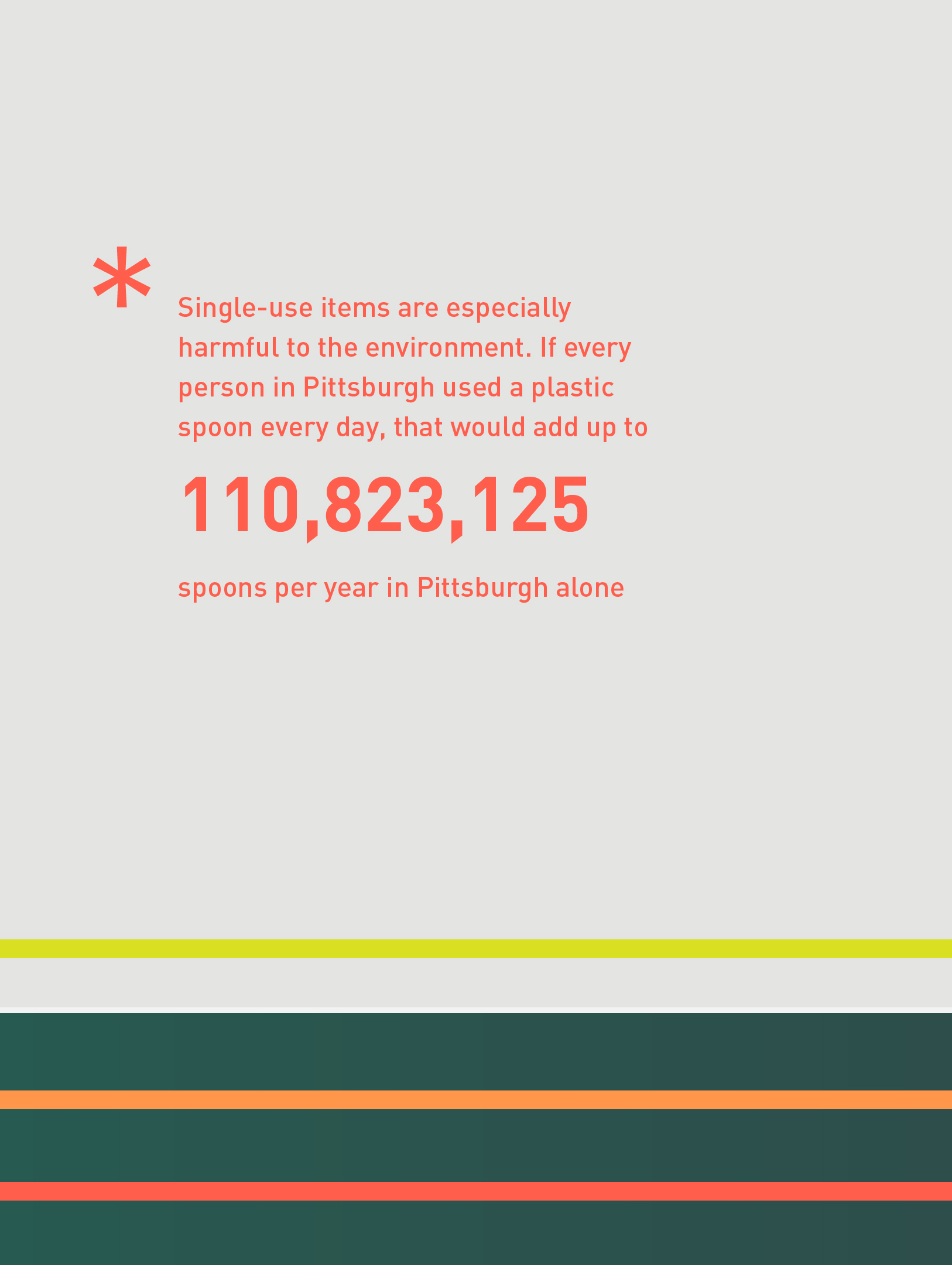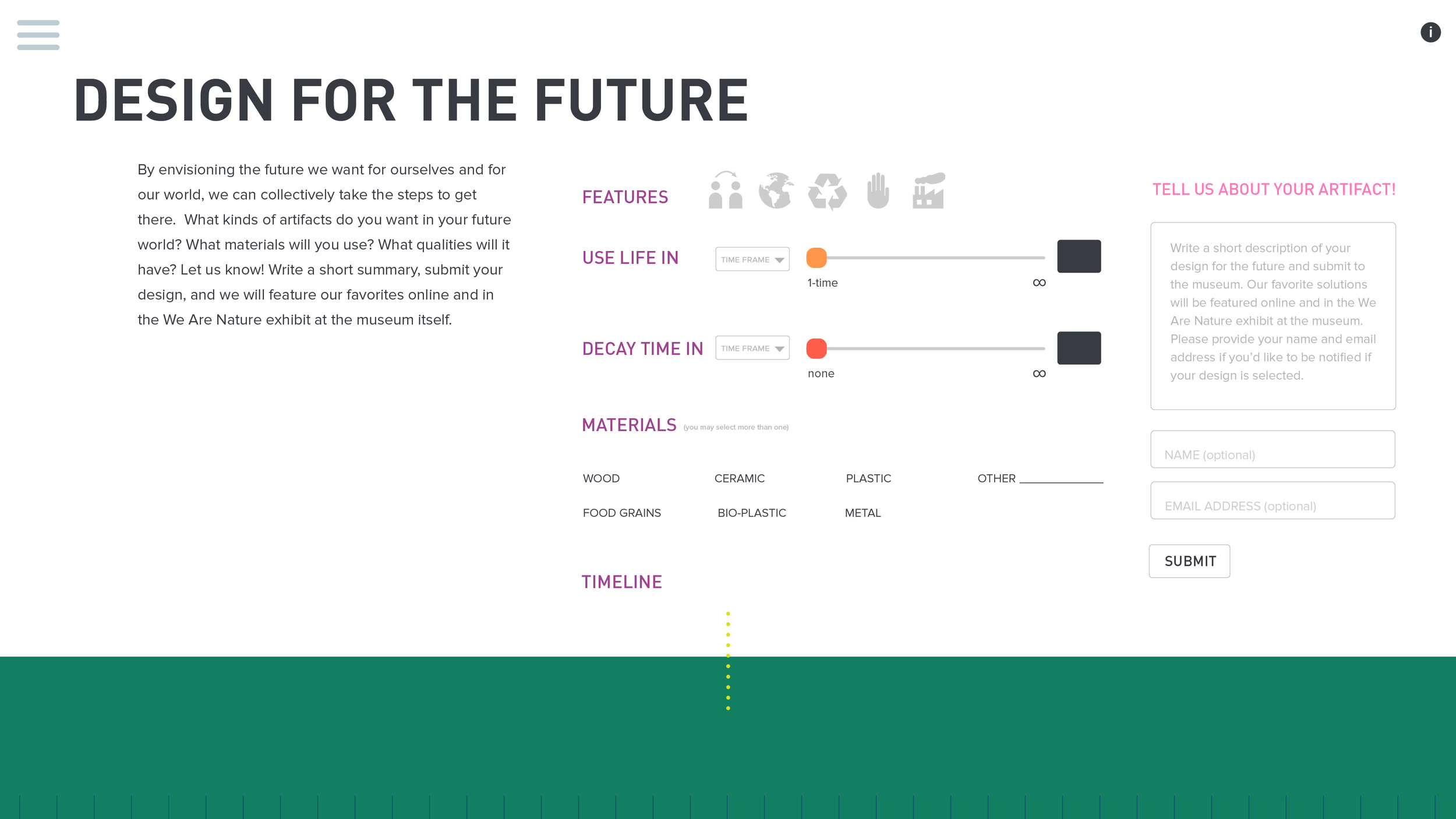INTRODUCTION
CLIENT:
Carnegie Museum of Natural History
BRIEF:
Design an interaction for the Carnegie Museum of Natural History
SOLO PROJECT
TIMEFRAME:
5 weeks
TOOLS:
invision / illustrator / photoshop / after effects
This project was based on an exhibit at the Carnegie Museum of Natural History (CMNH) called "We are Nature: Living in the Anthropocene." The Anthropocene marks the epoch of significant human impact on the environment, indicating that human activity has significantly altered the geological makeup of the planet. As the only exhibit of its kind in North America at the time, it was an important step for the Museum in tackling the topic of human-caused climate change.
Though the exhibit does an excellent job of demonstrating the profound and long-lasting effects of human activity, it does not take a strong stance on humans as actants. Acknowledgement of our personal contribution and a recognition that we can do something about it are both needed to trigger behavior change on an individual level. Thus, communicating both accountability and agency became the most important part of this exploration.
PROBLEM DEFINITION
My project brief was: Explore the potential for a supplementary interactive system to the We Are Nature exhibit that communicates human’s role and agency in the Anthropocene and sparks behavior change.
Though multinational corporations play their role in contribution to the destruction of the environment, we each individually perpetuate those damaging practices through our consumer culture; our dollars fuel the continuous destruction of the Earth. In my view, changing consumer behavior is the single most powerful thing an individual can do to halt the negative effects of the Anthropocene. For this reason, I decided to communicate ideas of accountability and agency through everyday consumer objects—namely a spoon.
PRIMARY GOALS
Convey a sense of agency and responsibility
Encourage people to evaluate their consumption habits
Educate and inform visitors about objects, consumer behavior, and the consequences of those behaviors
Bring awareness to the historic and multi-generational impact of our consumer habits
Appeal to all age groups
SECONDARY GOALS
Present alternatives and spark interest in new technologies
Bring awareness to the relevance of ancient, more holistic practices and attitudes towards the earth
Educate about the sometimes destructive practices of material extraction, production, and disposal on the earth
Communicate different approaches and philosophies of human’s relationship to nature
More information on the research process is available in the process documentation.
FINAL CONCEPT
I wanted to impart to visitors a greater sense of of the link between materials we use to produce consumer goods, our consumption of those goods, and the long-lasting impact on the environment. I decided to present this by illustrating the life cycle of a spoon and the various materials used to produce a spoon. By this, I hoped to provoke users to reflect on how objects were made, used, and disposed of before modern technology and today, and how the change in consumption habits impacted the earth. To take this one step further, I wanted viewers to "design their own" artifact for the post-Anthropocene era. In so doing, users would be forced to reflect on the issues raised in the timeline, recognize their role in the Anthropocene, and empower them to design a better future.
"Artifacts of the Anthropocene" is a play on words—in the design world objects are referred to as artifacts, but artifacts can also mean remnants of a particular period of time. The image of the landfill is a powerful visual of the remnants of modern consumption habits and the artifacts we leave behind for future generations.
THE TIMELINE
For this component of the project, I focused on aspects of materiality that most relate most to consumerism—namely, how it is made (by factory or by hand), its disposal (recyclable or biodegradable), and how long it is intended to stay in one’s possession (“heirloom item”).
The change in color of Earth (represented by the green bar at the bottom) reflects CO2 levels and also conveys the change in the earth over the course of history. This component of the timeline demonstrates how changes to the earth were subtle but also sudden.
Showing the use life and decay life visually in terms of colored bars allows for relative comparison: how long am I using this, and how long does it persist on Earth? The bars that remain in "Earth" for a long time crowd up and lead to a landfill. The actual times are also written in the descriptions for users to see more specific metrics.
Communicating the number of spoons that get used over 365 days is another visual representation of how disposable objects accumulate over time. Multiplying by the entire population of Pittsburgh makes that even more clear.
DESIGN YOUR OWN
I wanted to empower users to take what they learned from the timeline and do something good with it. So the final stage of the interaction asks users to think about the future they want, and to design their own artifact for the post-Anthropocene world. Designing one’s own artifact of the future helps to connect users to the future and make them invested in finding ways to improve it.
This is the most important element of the interaction, as it is what helps people translate what they learned through the timeline into action. When designing, they are forced to consider factors like biodegradability, use life, materials, and the overall impact those decisions have on the earth in terms of the changing color of green. They learn that there is no easy answer; it’s not just a matter of extending use life and reducing decay life, because the materials options also deactivate based on other factors. Users are alerted if their decisions are not sustainable or contribute to the degradation of the environment.
I realize these factors are only one part of the story, and there may be other options users would want that are not listed here. For this reason, I provided an option to add a description to support the design. By offering to feature the best designs in the museum and online, users are encouraged to be creative to find the best solution for the future.
FINAL PAGE
The final page encourages advocacy by allowing users to save their reports and to share their ideas on social media. Recognizing that simply designing an object is not enough, there are additional suggestions for changing consumer habits to have less impact on the earth. These suggestions intend to drive home considerations like shortening the supply chain, reusing or donating items instead of throwing them away, and investing in products that last long.


















